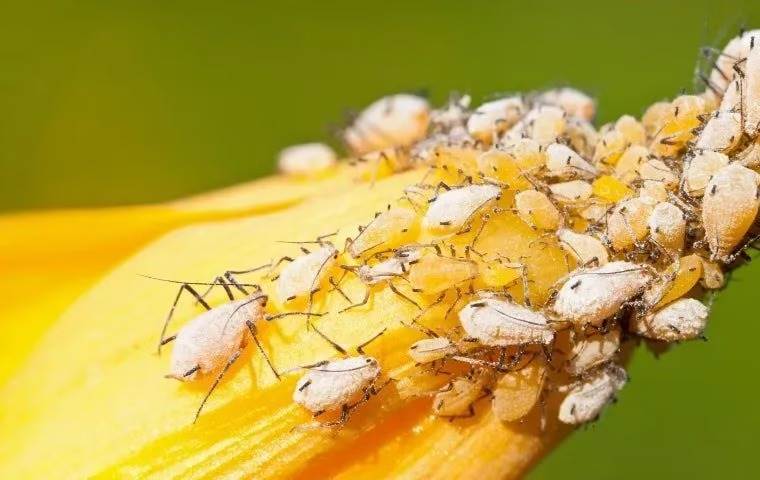
Aphid Identification in Florida
Identifying Aphids in Florida

If you're a Florida resident, you may be all too familiar with the small sap-sucking insects known as aphids
These pests are quite common in Florida and are known to infest plants in gardens and agricultural fields, causing significant damage and disrupting the ecosystem by spreading diseases.
By controlling these pests, gardeners, and farmers in Florida can work towards healthier plants, improved crop yields, and a more balanced ecosystem.
Key Takeaways
- Aphids in Florida can cause significant damage to plants, crops, and ecosystems through direct feeding and disease transmission.
- Understanding aphid life cycles and reproduction is essential for implementing effective control strategies.
- Comprehensive aphid management in Florida involves a combination of preventive measures, monitoring, and promoting beneficial insects within the ecosystem.
Understanding Aphids in Florida
Appearance and Identification
Aphids are small, pear-shaped insects that come in various colors, including green, yellow, red, black, and brown. These tiny creatures can be winged or wingless, depending on their stage of development and environmental factors.
Adult females are usually wingless, while adult males may have wings.
Nymphs, the immature stage of aphids, often resemble smaller versions of the adult females. They can be found in large groups on the leaves and stems of plants, feeding on plant sap, particularly on new-growth hibiscus and gardenia.
Because they are often in large groups, they are typically easy to spot on host plants.
Species Diversity in Florida
Florida is home to a diverse range of aphid species, including:
- Green peach aphid: This green species is commonly found in fruit and vegetable crops.
- Melon aphid: Also referred to as the cotton aphid, melon aphids can either be yellow, green, or black.
- Brown citrus aphid: As the name suggests, these aphids are brown and mainly feed on citrus plants.
Understanding the characteristics of these common aphid varieties is key to proper pest control management.
-
Do mosquito control services work?
When you choose to have professional mosquito control performed on your property, you will see a dramatic reduction in the mosquito populations around your yard.
By maintaining monthly treatments, these results will continue. We are so confident in the effectiveness of our mosquito control programs that we guarantee them with free follow-up treatments if needed in-between regular services.
-
How do you control mosquitoes in the yard?
At Native Pest Management, our technicians start their mosquito control service by inspecting your landscape for standing water. We then treat the standing water we find every month with biological larvicides to prevent mosquitoes from breeding.
Then, we perform a pet safe mosquito misting of the landscape to eliminate adult mosquitoes and prevent mosquitoes from finding harborage in your landscape. This guaranteed service should last approximately 30 days.
-
Can pest control get rid of mosquitoes?
No pest control treatment will eliminate every mosquito on your property.
However, with our two-step mosquito control service, we have been told by product manufacturers to expect a 90% reduction in the mosquito population.
Since we believe in the effectiveness of our mosquito control programs, we guarantee them with free follow-up treatments if needed in-between regular services.
Aphid Life Cycle and Reproduction
Aphids produce quite rapidly, and the various stages of their life cycles provide unique vulnerabilities to pest control measures, which is why understanding what stage they’re at is crucial
Let’s look at the distinctive growth stages and reproductive strategies of these soft-bodied insects.
Aphid Growth Stages
Aphids go through four main growth stages in their life cycle: egg, nymph, molt, and adult. Here is a brief overview of each stage:
- Egg: Some species of aphids lay eggs, which overwinter on plants and hatch when conditions are favorable.
- Nymph: After hatching, the tiny aphids are called nymphs. They are similar in appearance to adults but smaller and without wings. Nymphs feed on plants and go through four molts to reach adulthood.
- Molt: During each molt, the aphid sheds its exoskeleton to accommodate its growing size.
- Adult: The final stage, adult aphids, are typically wingless but can develop wings in some circumstances, which we'll discuss below.
Reproductive Strategies
Aphid populations have the unique ability to grow rapidly using two primary reproductive strategies: sexual and asexual reproduction.
- Asexual Reproduction: Most aphids reproduce asexually, meaning that female aphids give birth to genetically identical offspring (clones) without needing a mate. This process, known as parthenogenesis, enables aphids to produce numerous generations quickly, sometimes giving birth to several nymphs per day.
- Sexual Reproduction: In some cases, particularly when the environmental conditions become less favorable, aphids switch to sexual reproduction. During these times, adult females produce winged forms of both males and females, known as alates, which fly to new plants, mate, and lay eggs that will overwinter and hatch the following year.
With abundant food and limited space, winged aphids develop more frequently, helping the population disperse and colonize new plants.
Aphids' Impact on Plants and Ecosystems
Feeding Habits and Plant Damage
These garden pests feed on the sap of plant leaves and shoots using their specialized mouthparts.
If unchecked, the saliva from aphid infestations can lead to severe plant damage. Some signs of aphid infestation to look out for include:
- Curling or distorted leaves
- Stunted growth of shoots
- Yellowing leaves
- Presence of honeydew on leaves
They also excrete a sugary substance called honeydew, which can lead to the growth of a black fungus known as sooty mold if not swiftly dealt with.
Sooty Mold and Plant Viruses
When sooty mold appears on plants, it blocks the sunlight necessary for photosynthesis, eventually causing the plant to wither and die.
Beyond their feeding damage, aphids transmit harmful plant viruses as they move from one plant to another
If left unchecked, this transmission can lead to widespread infection and destruction of valuable crops.
Aphid Control Strategies
Now that you have a decent understanding of these pesky insects, let’s look at some popular control strategies that can be employed to keep them at bay.
Cultural and Mechanical Control
Cultural and mechanical control strategies involve altering the plant's environment or physically removing the aphids to reduce their impact. Some effective methods include:
- Intercropping: Plant a variety of crops together to discourage aphid infestations.
- Pruning: Regularly trim plants to remove infested areas and promote airflow.
- Barriers: Use netting or row covers to exclude aphids from plants.
- Water Spray: Dislodging aphids from plants by spraying them with a strong jet of water.
Biological Control Methods
Biological control methods involve using natural enemies to help manage and control aphid populations. Some beneficial insects and organisms effective against aphids are:
- Lady Beetles: Both adult ladybugs and ladybug larvae can consume up to 60 aphids daily.
- Lacewings: Both adult and larval lacewings actively prey on aphids, making them valuable allies in aphid control.
- Parasitic Wasps: Some species of wasps lay their eggs inside aphids, resulting in the death of the aphid host.
- Natural Predators: Encourage natural aphid predators like birds, spiders, and other insects to visit your garden by providing suitable habitats.
Chemical Control Options
Chemical control options can be used as a last resort when other control methods fail. Here are a few eco-friendly alternatives to conventional insecticides:
- Insecticidal Soap - This unique formula kills aphids by damaging their exoskeleton, causing them to lose moisture and desiccate.
- Horticultural Oil - This solution suffocates aphids by clogging their airways
- Neem Oil - Derived from the neem tree, this oil disrupts aphids' development and reproductive system.
- Systemic Pesticides - Applied to the soil, plant roots take up these pesticides, making the plant tissue toxic to aphids.
We also offer a wide range of preventative pest control measures to help get ahead of problems before they get out of hand.
Preventive Measures and Monitoring
Integrated Pest Management
Adopting an Integrated Pest Management (IPM) strategy is a friendly and effective way to rid yourself of these pests.
Our IPM strategies focus on long-term prevention, incorporating a combination of pest control techniques, including:
- Biological control: Encourage natural predators of aphids, like ladybugs, green lacewings, and parasitic wasps, by planting flowering plants that attract them rather than using harmful broad-spectrum insecticides.
- Habitat manipulation: Interplanting susceptible plants with strong-scented plants can confuse and repel aphids over long periods
- Cultural practices: Regularly pruning plants and removing infected leaves can reduce aphid populations. You can also use slow-release fertilizers to encourage moderate plant growth rates.
- Resistant varieties: Select plant varieties that are aphid-resistant to aphids, such as fennel or marigolds.
Regular Monitoring and Assessment
Monitoring your plants regularly for any signs of aphid activity is essential, as early detection can help implement control measures more effectively.
Make a habit of inspecting your plants at least once a week. Look out for signs of aphid infestations, including the presence of live aphids on the undersides of the leaves, curling leaves, and colonies of ants.
Avoiding Harm to Non-Pest Species
While protecting your plants from aphids, it is essential to ensure that non-pest species are not harmed.
If you decide to deal with the presence of aphids on your own, be selective in your choice of insecticides and opt for organic or less toxic options.
Monitor your garden closely to identify any non-target insects that may be affected by treatments and adjust your approach accordingly.
Top-Tier Pest Control Services
Here at Native Pest Management, our goal is to protect your investments from unwanted pests, whether in your garden, your crops, or your home.
We offer quality pest management services to residents throughout South Florida, so if you’re looking to keep out pests for good, whether aphids, mealybugs, whiteflies, scales, or other garden-infesting species, get in touch with us today to learn more!

Why Choose Native Pest Management?
We Exceed Customer Expectations
-
Pet Friendly & Environmentally ConsciousNative Pest Management applies our pest control products with the safety of your family and pets in mind! We also offer eco-friendly pest control to protect your family and the planet.
-
Local Service ProfessionalsSince 2015, we have served communities in West Palm Beach and all throughout South Florida. Our team is fully licensed, insured, and vetted.
-
On TimeOur team will not only arrive on time, but they’ll also go above and beyond when providing service. It’s what makes us one of the top rated pest control companies in Florida! We strive for complete customer satisfaction every time.
-
Get a 100% Free Estimate
Whether you currently have pests in your home or simply want to start professional pest prevention, take the first step to a pest-free life, and contact us today for your free pet-friendly pest control quote.
-
“Warren took his time with the servicing and was very knowledgeable! Exceptional customer service. I will be requesting him each time.”- Montiea Singletary
-
“Excellent service by Chino from Native Pest Management. Chino went above and beyond to make sure we understood everything about the service and kept us very informed during the process.”- Brand Gonzalez
-
“Truly professionals at what they do. very respectful very knowledgeable and great attitude.”- Jorge Acosta
-
“I called and spoke to the manager, who was polite and courteous, and even though it cost them money to come back out and spray, they did not charge me again, and I was very thankful.”- S. Williams
-
“Dale is the absolute best in the business of pests! My sister and I personally ask for him every single time because he always goes above and beyond.”- Zariah Graham
-
“The technician was very professional. He explained things thoroughly and put me at ease with what was about to happen in my home.”- Anthony Diaz
-
“Native pest management always exceeds my expectations! The people who answer the phone are so nice and accommodating and make scheduling a breeze! The techs are always so nice and do a great job.”- Michelle Cato
-
“Extremely impressed with the technicians I met today. Tony and Jamie. Very thorough and customer oriented. I am expecting great things for my trees and plants.”- Curt Kredo

Native Pest Management's Blog
Want all the latest news or updates? Browse through our blog to read our most recent posts and featured articles.







